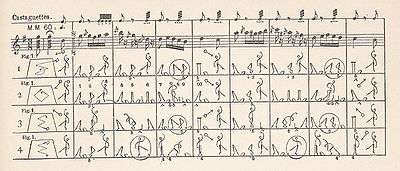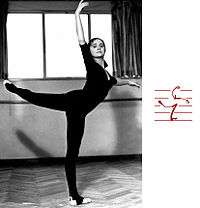Dance notation

Dance notation is the symbolic representation of human dance movement and form, using methods such as graphic symbols and figures, path mapping, numerical systems, and letter and word notations. Several dance notation systems have been invented, many of which are designed to document specific types of dance. A dance score is recorded dance notation that describes a particular dance.
Usage
The primary uses of dance notation are historical dance preservation through documentation, and analysis (e.g., in ethnochoreology) or reconstruction of choreography, dance forms, and technical exercises. Also, dance notation allows a dance work to be documented and therefore potentially copyrighted.
Two popular dance notation systems used in Western culture are Labanotation (also known as Kinetography Laban) and Benesh Movement Notation. Others include Eshkol-Wachman Movement Notation and DanceWriting.
Several notation systems are used only for specific dance forms. Examples of such systems include Shorthand Dance Notation for dances from Israel, Morris Dance Notation for Morris dance, and Beauchamp-Feuillet notation for Baroque dance.
Many dance notation systems are specifically designed for European dance and, as a result, cannot effectively describe dances from other cultures. Examples of such non-European dances include the polycentric dances of many African cultures, where movement of the body through space is less important than form-changing movements.
History

In the 1680s, Pierre Beauchamp invented a dance notation system for Baroque dance. His system, known as Beauchamp-Feuillet notation, was published in 1700 by Raoul-Auger Feuillet and used to record dances throughout the eighteenth century.
A well-known collection of dance scores is the Sergeyev Collection, recorded using Vladimir Ivanovich Stepanov's notation method (1892). This collection documents the Imperial Ballet's (today the Kirov/Mariinsky Ballet) repertoire from the turn of the 20th century, including Marius Petipa's original choreographic designs for The Sleeping Beauty, Giselle, Le Corsaire, and Swan Lake, as well as Coppélia and the original version of The Nutcracker. It was with this collection that many of these works were first staged outside Russia.
Kahnotation was developed from 1930-1950 and published in 1951 by Stanley D. Kahn. The notation focuses on notating weight change in time and the various types of anatomical moves used in tap dance.
In 1948, Hanya Holm became the first Broadway choreographer to have her dance scores copyrighted, for her work on Kiss Me Kate.
In 1975, Ann Hutchinson Guest reconstructed choreographer Arthur Saint-Léon's Pas de Six from his 1844 ballet La Vivandière, along with its original music by composer Cesare Pugni, for the Joffrey Ballet. The piece was reconstructed from Saint-Léon's work, which was documented using his own method of dance notation, known as La Sténochorégraphie.
In 1982, the first computerized notation system—the DOM dance notation system—was created by Eddie Dombrower for the Apple II personal computer.[1] The system displayed an animated figure on the screen that performed dance moves specified by the choreographer.
See also
- Action stroke dance notation
- Motif Description, a subset of Labanotation
References
- ↑ Dance Notation Journal (Fall): 47–48. 1986. Missing or empty
|title=(help)
Further reading
- Cage, J. and Knowles, A. (1973) Notations. Reprint Services Corp. ISBN 0-685-14864-5
- Drewes, Henner (2003) Transformationen - Bewegung in Notation und digitaler Verarbeitung in Fellsches, J (Ed) Folkwang-Texte Bd. 18. Verlag Die Blaue Eule, Essen. ISBN 3-89924-057-X
- Hutchinson Guest, A. (1989) Choreographics: a comparison of dance notation systems from the fifteenth century to the present. Routledge ISBN 90-5700-003-2
- Kahn, Stanley D. (1951). "presenting Kahnotation: the K-Symbols for writing Tap Dancing"
- Neagle, R.J. and Ng, K.C. (2003) Machine-representation and visualisation of a dance notation in Proceedings of electronic imaging and the visual arts - London July 2003
External links
- Dance notation at Curlie (based on DMOZ)